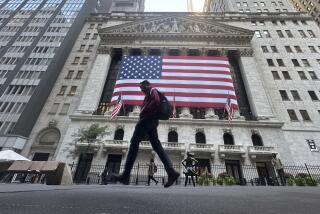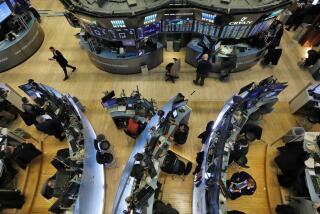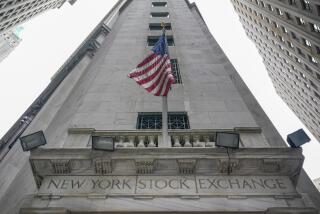Laughing All the Way to the . . .
- Share via
George Salem, analyst with Gerard Klauer Mattison & Co. in New York, sums up in one sentence Wall Street’s view of bank stocks: “Don’t sell your bank stocks, and it’s not too late to buy.”
“There is no question this group has had a hell of a run. Bank stocks have been market leaders all year,” Salem said.
Yet given the banking industry’s earnings outlook, analysts say, it’s not a matter of whether to have bank stocks in an investment portfolio but which ones to buy.
In the last several years, the love affair between investors and bank stocks has hit the skids only with the threat of higher interest rates. For example, the stocks of major banks dipped nearly 6% over four days earlier this month on fears that the Federal Reserve Board might raise short-term interest rates.
But any pullback in the stocks since 1991 has turned out to be a good buying opportunity. And one continuing attraction of the stocks is their low price-to-earnings ratios compared with the average blue-chip stock.
The average bank stock in the Standard & Poor’s bank composite index is priced at 15.6 times most recent four quarters’ earnings per share. In contrast, the average blue-chip stock in the S&P; 500 index has a P/E of 21.1 based on most recent four quarters’ earnings.
Analysts say banks would command higher P/Es were it not for a history of unreliable earnings as a result of problem loans. They cite the commercial real estate crisis of the early 1990s, when many banks held loans that soured.
“I think one of the main reasons why bank stocks don’t get the same multiple as the market is the lack of consistency,” said David C. Stumpf, senior bank analyst for A.G. Edwards & Sons Inc. in St. Louis.
Historically, “Every two years the industry shoots itself in the foot with a credit problem,” Stumpf said. “But banks have now gone six years without any material credit problems. If that string continues, bank valuations should continue to rise.”
Overall, many analysts say the risks for bank stocks are manageable. Some analysts favor small regional banks that have developed profitable niches and shown double-digit growth. Others recommend investing in larger ones such as NationsBank, Chase Manhattan and BankAmerica.
“It’s boiled down to which banks are . . . developing their business strategy to continue to grow,” Stumpf said.
Commercial banks reported total earnings of $13.2 billion for the third quarter, the third-highest level ever, according to the Federal Deposit Insurance Corp. FDIC Chairman Ricki Helfer said if commercial banks’ performance remains on track, the industry’s earnings for the year will reach an unprecedented $50 billion.
“Banks are in a unique period right now. It’s never been this good. It’s like having all the planets in alignment,” Salem said. “Interest rates are looking flat. Inflation is in control. And there aren’t any loan quality problems that are looming.”
That hasn’t gone unnoticed by the market, of course. Although cheap compared with the rest of the market, “bank stocks are approaching trading at multiples that are higher than they have been in many years,” said Michael J. Coiro, an analyst with Johnston, Lemon & Co. in Washington.
Yet given the relatively unattractive 1997 earnings outlook for many other industries, A.G. Edwards expects money to continue to flow into bank stocks even if valuations are driven to the high end of historical ranges. Stumpf said the 35 bank stocks that A.G. Edwards follows as a group are expected to gain 10% to 12% in 1997, on average, compared with just 4% for the S&P; 500.
However, most analysts agree that bank stock valuations will still lag the market until the industry proves it can withstand a major blow without showing large losses.
The major risks to banks in 1997? If the economy booms and the Fed is forced to raise short-term interest rates; or if recession hits and credit losses, such as on consumer credit cards, suddenly balloon beyond banks’ expectations. Yet in response to higher delinquency rates, many banks have already begun to tighten lending standards, analysts note.
(BEGIN TEXT OF INFOBOX / INFOGRAPHIC)
Money in the Banks
Bank stocks’ prices have risen dramatically in 1996, but they still tend to sport lower price-to-earnings ratios than other types of companies. Below, the 10 largest stocks (by weighting) in the Standard & Poor’s bank composite index, with performance through Friday:
*--*
Name Ticker P/E* Friday close YTD % chg. Banc One ONE 14.2 $44.88 31.2% BankAmerica BAC 14.4 102.38 58.1 Chase Manhattan CMB 18.4 92.13 56.9 Citicorp CCI 14.3 106.38 58.2 First Chicago NBD FCN 15.6 56.13 42.1 First Union FTU 15.5 75.38 35.5 J.P. Morgan JPM 13.5 99.88 24.4 NationsBank NB 12.9 99.38 42.7 Norwest NOB 15.2 45.38 37.5 Wells Fargo WFC 15 278.63 28.9
*--*
Source: Bloomberg Business News
*Based on most recent four quarters’ earnings-per-share
More to Read
Inside the business of entertainment
The Wide Shot brings you news, analysis and insights on everything from streaming wars to production — and what it all means for the future.
You may occasionally receive promotional content from the Los Angeles Times.










